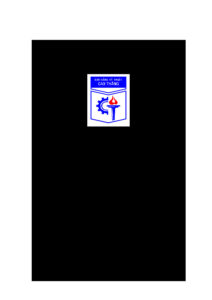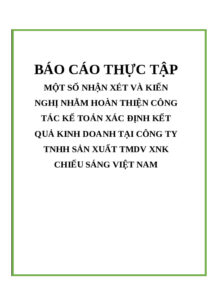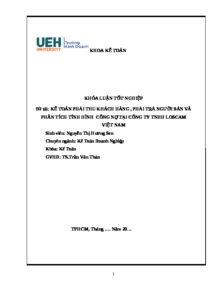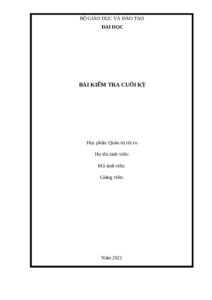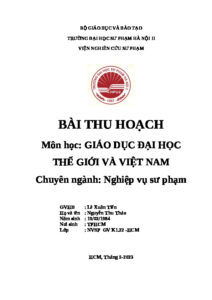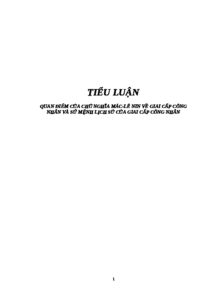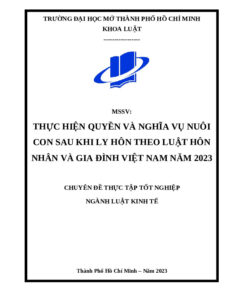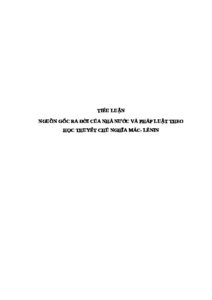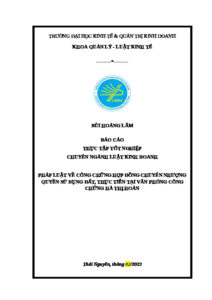Kế Toán Tiền Lương Tại Ngân Hàng Sacombank ,Chi Nhánh Thủ Đức
Kế Toán Tiền Lương Tại Ngân Hàng Sacombank ,Chi Nhánh Thủ Đức Topic: Factors Affecting The Decision To Buy Cosmetics Online In Hanoi
Bạn đang xem trước 15 trang tài liệu Kế Toán Tiền Lương Tại Ngân Hàng Sacombank ,Chi Nhánh Thủ Đức, để xem tài liệu hoàn chỉnh bạn click vào nút DOWNLOAD ở trên
TOPIC: FACTORS AFFECTING THE DECISION TO BUY COSMETICS ONLINE IN HANOI TABLE CONTENTS LIST OF TABLES...............................................................................................................8 LIST OF FIGURE............................................................................................................9 CHAPTER 1: INTRODUCTION..................................................................................10 1.1. The urgency of subject........................................................................................10 1.2 Research situation...............................................................................................11 1.2.1 Research situation abroad................................................................................11 1.2.2 Researches in our country...............................................................................13 1.3 Research purpose and tasks................................................................................15 1.3.1 Research purposes...........................................................................................15 1.3.2 Research mission.............................................................................................15 1.4 Object and scope of study...................................................................................16 1.4.1 Research subjects............................................................................................16 1.4.2 Research scope................................................................................................16 1.4.3 Research question............................................................................................17 1.5 New contributions and meaning of topic............................................................17 1.5.1 New contributions of topic..............................................................................17 1.5.2 The significance of the study of study............................................................18 1.6 Structure of study................................................................................................18 CHAPTER 2: THEORETICAL BASIS AND RESEARCH MODEL.............................20 2.1 Some related concepts.........................................................................................20 2.1.1 Cosmetic concept............................................................................................20 2.1.2 Classification of cosmetics..............................................................................21 2.1.3 Concept of intention to buy.............................................................................22 2.1.4 The concept of e-commerce and e-commerce platform..................................22 2.2 Foundation theory...............................................................................................24 2.2.1 TRA – Theory of Reasoned Action.................................................................24 2.2.2 Theory of Planned Behavior (TPB)................................................................26 2.2.3 Technology Acceptance Model (TAM)..........................................................26 2.3 Research on issues related to the topic...............................................................28 2.3.1 Factors affecting the intention to buy cosmetics online:(Shirin & Clara (2015) - Consumers' online purchase intention in cosmetic products)..................................28 2.3.2 Factors influencing online shopping behavior - Mediating role of shopping intention: (Abdullah Osman, Yi Jin Lim, Shahrul Nizam Salahuddin, Abdul Rahim Romle & Safizal Abdullah (2016). Factors influencing online shopping behavior. : the mediating Factors influencing role of purchase intention....................................29 2.3.3 Impact of User Generated Content (UGC) for product reviews on online purchases – Conceptual Framework: (Azlin Zanariah Bahtar & Mazzini Muda (2016). The impact of user – generated content (UGC) on product reviews towards online purchasing – a conceptual framework)...........................................................31 2.4 Proposed research model and research hypotheses............................................33 2.4.1 Proposing a research model.............................................................................33 2.4.2 Research hypotheses.......................................................................................34 CHAPTER 3: RESEARCH METHODS...........................................................................40 3.1. Research design:.....................................................................................................40 3.1.1. Brief description of the research process.........................................................40 3.1.2. Research flow chart..........................................................................................42 3.1.3. Building a scale................................................................................................43 3.2.Data collection sources and methods.......................................................................48 3.2.1. Questionnaire design........................................................................................48 3.2.2. Test survey.......................................................................................................49 3.2.3. Methods for determining sample size and selecting samples...........................50 3.2.4. Methods of data collection and sampling.........................................................50 3.3. Data Analysis Methods...........................................................................................51 3.3.1. Check the reliability of the scale through the reliability coefficient Cronbach's Alpha..........................................................................................................................51 3.3.2. EFA . exploratory factor analysis.....................................................................51 3.3.3. Pearson's correlation analysis...........................................................................52 3.3.4. Regression analysis..........................................................................................52 3.3.5. One-way t-test and ANOVA for demographic variables.................................53 CHAPTER 4: RESEARCH RESULTS.............................................................................55 4.1. Description of the study sample/Descriptive statistics...........................................55 4.1.1. General Statistics..............................................................................................55 4.1.2. Information about the user's e-commerce platform type..................................56 4.2. Cronbach's Alpha coefficient analysis....................................................................57 4.2.1 Factor Perceived usefulness..............................................................................57 4.2.2. Ease of Use Perception Factor..........................................................................57 4.2.3. Risk Perception Factor.....................................................................................58 4.2.4. The factor of shopping enjoyment....................................................................58 4.2.6. Purchase Intent Factor......................................................................................58 4.3. EFA exploratory factor analysis.............................................................................60 4.3.1. Exploratory factor analysis EFA for independent variables for the 1 time......60 4.3.3. Exploratory factor analysis EFA for the dependent variable...........................63 4.4. Research model after adjustment............................................................................64 4.4.1. Research models...............................................................................................64 4.4.2. Hypotheses.......................................................................................................65 4.5. Build regression equation.......................................................................................65 4.6. Multivariate regression analysis results..................................................................66 4.6.1. Correlation coefficient test...............................................................................66 4.6.2. Multivariate regression analysis results...........................................................68 4.5.3. Test the research hypothesis.............................................................................69 4.6. Detect necessary assumption violations..................................................................70 4.6.1. The phenomenon of multicollinearity..............................................................70 4.6.2. Test assumptions about the normal distribution of the residuals.....................71 4.6.3. Assuming a linear relationship as well as the phenomenon of constant error variance......................................................................................................................73 4.7. Test the difference according to individual characteristics to the dependent variable ........................................................................................................................................74 4.7.1 Gender Variation...............................................................................................74 4.7.2. Variable Age.....................................................................................................75 4.7.3. Variable Education Level.................................................................................76 4.7.4. Income Variables..............................................................................................77 4.8. Discussing research results.....................................................................................78 4.8.1. Perceived usefulness:.......................................................................................78 4.8.2. Perceived ease of use........................................................................................79 4.8.3. Risk perception:................................................................................................80 4.8.4. Shopping enjoyment:........................................................................................80 4.8.5. Attitude to UGC:..............................................................................................80 Summary of chapter 4:.......................................................................................................81 CHAPTER 5: CONCLUSIONS AND IMPLICATIONS.................................................82 5.1 Conclude.............................................................................................................82 5.2 Implications.........................................................................................................82 5.2.1 Risk perception................................................................................................82 5.2.2 Attitude to UGC..............................................................................................83 5.2.3 Perceived ease of use.......................................................................................84 5.2.4 Shopping enjoyment........................................................................................86 5.2.5 Perception of usefulness..................................................................................86 5.3 Research limitations and future research directions...........................................86 LIST OF TABLES Table 2.1Summary of research variables in the model......................................................29 Table 3.1Scale of perceived usefulness.............................................................................41 Table 3.2Easy-to-use Perception Scale..............................................................................42 Table 3.3Scale of Risk Perception.....................................................................................42 Table 3.4Scale of shopping enjoyment..............................................................................43 Table 3.5Scale of Attitudes towards UGC........................................................................44 Table 4.1Statistical results of the survey sample..........................................................53 Table 4.2E-commerce platform and corresponding number of consumers.......................54 Table 4.3Cronbach's Alpha test results..............................................................................56 Table 4.4Summarize results of coefficients in EFA factor analysis for independent variables for the 1 time......................................................................................................57 Table 4.5Summarizing the results of coefficients in EFA factor analysis for independent variables for the 2nd time..................................................................................................58 Table 4.6Result of 2nd factor rotation...............................................................................59 Table 4.7Coefficients in EFA factor analysis for dependent variable...............................60 Table 4.8Correlation coefficient test results......................................................................63 Table 4.9Model summary results......................................................................................65 Table 4.tenF-test in ANOVA . analysis.............................................................................65 Table 4.11Regression analysis results...............................................................................66 Table 4.twelfthResearch hypothesis test results................................................................67 Table 4.13Results of the test of differences by sex...........................................................73 Table 4.14Results of testing the difference by age............................................................73 Table 4.15The results of the test of differences by education level..................................74 Table 4.16Income difference test results...........................................................................75 LIST OF FIGURE Figure 2.2TPB model.....................................................................................................................24 Figure 2.3TAM . model.................................................................................................................26 Figure 2.4Model of factors affecting the intention to buy cosmetics online.................................27 Figure 2.5Model of factors affecting online shopping behavior...................................................28 Figure 2.6ModelUGC's Impact on Online Purchase.....................................................................30 Figure 2.7Proposed research model...............................................................................................32 Figure 4.1Research model after adjustment:.................................................................................62 Figure 4.2Histogram......................................................................................................................70 Figure 4.3PP Plot . Chart...............................................................................................................72 Figure 4.4Scatter graph..................................................................................................................73 CHAPTER 1: INTRODUCTION 1.1. The urgency of subject After more than 30 years of renovation, integration and development (from 1986 up to now), especially since Vietnam officially became a member of the World Trade Organization (WTO), Vietnam's economy has become increasingly popular. deeply integrated into the world economy, the economy has made many outstanding and comprehensive development steps. According to the Ministry of Industry and Trade, GDP per capita increased from 730 USD in 2006 to 2,779 USD/person in 2020. Thereby, it can be seen that the income and living standards of consumers in Vietnam are increasingly improved and raised. The demand for "eating well, dressing warmly" is fighting being replaced by "eating well, dressing well", the trend of investing in self-care and beauty is also increasing. Since then, the beauty care, According to the development of society, their working environment is usually an office or an office, where they interact with many people around. Young people focused on appearance, must always be neat and tidy, create a beautiful image in the eyes of others, and improve their self-worth. Since then, the demand for beauty and cosmetics use among young people is increasing rapidly. And the use of cosmetics becomes a habit of consumers when going out, going out, going to work or simply to take care of themselves. According to the Ministry of Industry and Trade, the e-commerce market in Vietnam is currently growing quite rapidly with 35.4 million users and generated more than $2.7 billion in revenue in 2019. E-commerce report by countries Southeast Asia in 2019 by Google, Temasek and Brain&Company predicts that the average growth rate for the whole period 2015-2025 of Vietnam's e-commerce is 29%. It is forecasted that by 2025, the scale of Vietnam's e-commerce will reach $43 billion and rank third in ASEAN. These figures have proved that, when the outstanding development of society makes young people more active and working in the external environment, shopping on e-commerce platforms is more and more important. important. Besides, the developed economy also promotes the purchasing power of Vietnamese consumers. The boom of the cosmetics industry in recent years has created a widespread viral effect greatly thanks to e-commerce and social networking channels such as YouTube and Facebook. If before, cosmetics only appeared on shelves in stores or commercial centers such as Parkson, Vincom, Diamond... but today, consumers can conveniently shop online easily through electronic devices including desktop computers, tablets or simply smartphones. This form brings buyers a lot of interesting and interesting experiences by bringing a lot of benefits that traditional stores cannot provide such as fast, convenient, simple, time saving, money and still be able to shop at any time and anywhere. Especially in an era where everyone is constantly exposed to digital devices and the internet, the trend of buying cosmetics online has become inevitably. With this situation and trend, the author again affirms that the form of buying cosmetics on e-commerce platforms is once showing its position and is increasingly being chosen by consumers. From the above attraction, cosmetic companies need to understand and capture the ever-changing needs of customers in order to sell products more effectively, attract new customers and retain old customers. However, in order to have clear and accurate judgments about the behavior of a group of cosmetic consumers in general and a group of customers who have a preference for buying cosmetics online in particular, and how to attract for more and more customers to buy cosmetics online, formal research is required. The goal of this study is to help businesses in the cosmetics industry have a new direction in the future and understand the factors that affect purchasing behavior to have an investment plan for their sales channel. especially in the most vibrant and second largest market in Vietnam - Hanoi City. Stemming from that actual situation, the author chose the topic: “Factors affecting the decision to buy cosmetics online in Hanoi” make a thesis topic. 1.2 Research situation 1.2.1 Research situation abroad The global cosmetic market has been growing steadily since the 1990s, however, due to the impact of the Covid-19 pandemic, 2020, the cosmetics industry will witness a decline in growth rate for the 1 time in 2020. the number is not small - 8.0%. Such a decline, but the total value of the world cosmetics market is still estimated to be worth more than 200 billion euros (according to The world of beauty 2020 Post in L'Oreal's annual report column). Along with the popularity and influence of the cosmetic market, many research works related to cosmetics have appeared to detect, test and summarize related issues in many different aspects and levels. cùng. However, foreign research articles only go into each subject as "intent to buy cosmetics" or "intent to buy online", Research on cosmetic purchase intention: Research by E Janany and Shivany Shanmugathas (2017) conducted a survey with 200 female customers on the factors affecting the intention to buy skin care cosmetics in Jaffana district in the island nation of Sri Lanka. The study revealed the factors affecting consumer behavior including various aspects such as Brand, Education, Price and Civil Status. However, with a limited sample size, the study can only guarantee relative accuracy for women in the region, and this is by no means accurate and contribute much to future research. Because civil status and education factors are not really popular in many countries at present, especially in the period of strong development of science and technology, information technology and education like now. The study "The factors affecting the intention to buy cosmetics in Indonesia based on online reviews" by Latifa Putri and Harimukti Wandebori (2016) showed that the most important factors affecting the intention to buy cosmetics are “quality of eWOM”, followed by “reliability” of source”, “quantity of eWOM”, “attractiveness of information” and “perceived usefulness”. Limitations of research study in depth and diversity on forms of online word of mouth and do not open up future research directions. The study “Purchasing Cosmetics: A Preliminary Look at Gen-Y” by Uchenna Cyril Eze, Chew-Beng Tan and Adelene Li-Yen Yeo in Malacca, Malaysia in 2012 collected 204 valid responses from the response. Female users of Generation Y. Research shows that brand image has a special meaning in choosing cosmetic products for female consumers, in addition to other factors such as product image, product knowledge. Products and Promotions are also brought to the table for comparison and evaluation. A bright point of that study is to outline and suggest research directions for future works, such as taking the database on the behavior of the Y gene in the article, from which it is used as a measure to compare it with gen X or gene Z on related cosmetic consumption behavior. In addition, in 2015 Rahman and Jawaid (2015) proposed a model to study some factors affecting the trend of men's cosmetic consumption in Gen Y (young people in their 20s to 30s). The study shows the influence of the following factors on the trend of men's cosmetic consumption, including: Cosmetic packaging; Self-image; Brand Image and finally Celebrity Image. Finally, the study disproves the hypothesis about the impact of cosmetic packaging on consumer trends. Besides the contributions, this study still has some limitations such as the survey object is only in the Y gene, which does not only or suggest an approach for future research papers, Research on online purchase intent: Research on "Factors affecting online shopping behavior" by Hanu Uzaun and Mersif Poturak (2014). The author has pointed out factors including: Price expectations, Perceived risk, Subjective standards, Sales page interface design, Delivery time, Final experience and Convenience and quality Services have a strong impact on online purchasing behavior. But the biggest weakness of the study is that the sample size is too low (104), which reduces the verifiability and reflectivity of the work. In 2015, Yi Jin Lim and Abdullah Osman and colleagues conducted a study "Factors affecting online shopping behavior: mediating role of purchase intention". The factors of Subjective Criterion, Perceived usefulness and Intention to purchase are weighed for comparison. However, the survey scope of the study was limited to students at one university, so the generalizability is not high for a larger area. In the same year, the study "Factors affect the intention to buy products of brands by online shopping" by Haslinda Hasan, Arran Hai Harun and Mhd Shaffran Zainal Rashid showed that the the usefulness, Perceived ease of use, Brand factors have a strong impact on purchase intention. However, by the end of the study, only a low adjusted R2 was obtained (0.54). 1.2.2 Researches in our country The strong growth of the cosmetics market and the explosion in online shopping have fueled many studies in Vietnam, but the author has yet to find an in-depth study of the individual factors. Factors affecting specific cosmetic consumers on e-commerce platforms, but only at the general level of online shopping (including Digital, Social and E-commerce channels) Research by Pham Thi Ba (2013) with the topic "Personal factors affecting the cosmetic consumption behavior of men". Research has confirmed 6 factors affecting in decreasing order as follows: interest in skin health, awareness of the traditional role of skin care products, interest in social image, body attractiveness, self-image and the effects of age or aging process. However, the study has not made specific recommendations on the development of marketing and advertising strategies as the initial goal of the study, but only laid the foundation for future research. Research by Luu Thanh Duc Hai and Nguyen Kim Yen (2017) with the aim of "Analysis of factors affecting consumers' decision to buy skin care cosmetics in Can Tho City". The study confirms that the high quality factor has the strongest influence on consumer behavior. At the same time, the study also pointed out that the factors that help to change behavior include: brand, confusion because there are many options, price, brand loyalty, habits and aesthetics. However, the research paper has not mentioned aspects that change shopping behavior, especially in the era of digital transformation. With more modern and up-to-date research articles, we have a study on "Factors affecting consumers' intention to buy cosmetics online in Ho Chi Minh City" by Diep Thi Kim Tuyen and Dam. Tri Cuong (2021). The results of the study show that there are four main influencing factors, of which the second strongest influence is the perceived ease of use, the third on the quality of the website design, the fourth the perceived usefulness. However, the research model in the article has a consistent level with reality of 56.4%. Therefore, the remaining 43.6% of the intention to buy cosmetics online may lie in factors that the study has not mentioned such as: price, shopping enjoyment, product quality ,...Besides, The research paper is still quite limited in scope of the survey as well as a larger sample size is needed to more fully reflect the research problem. Therefore, these points can be considered as orientations for further in-depth studies in the future. The above are some studies related to the topic, but there are still points that have not been studied in depth and have high practical significance for consumers in Vietnam, but specifically in Ho Chi Minh City. In particular, studies on cosmetic consumption on e-commerce platforms are still quite limited, and there is no research topic on this topic with specific young people in Ho Chi Minh City. Therefore, the consumption consumption author that his topic will bring many new discoveries about the cosmetic behavior of specific young people e-commerce platforms - future trends. 1.3 Research purpose and tasks 1.3.1 Research purposes Realizing the urgency of the topic, the author has set out four research objectives: 1, determine the factors that affect the decision to buy cosmetics online in Hanoi. Second, analyze and evaluate the extent of the influence of factors on the decision to buy cosmetics online in Hanoi. . Third, propose measures to help business performance of cosmetic businesses that have been tending to develop e-commerce channels. Fourth, build transparent, accurate, reliable research with high scientific knowledge content, becoming a reference for future research in the same field. 1.3.2 Research mission 1, synthesize and systematize the concepts of research objects, theories of consumer behavior and previous studies. From there, we propose a research model and hypotheses that are suitable with the characteristics of the cosmetic industry, with the objectives of the study and with the conditions and feasibility of implementation in the area of Hanoi City. Second, organize a survey of consumers' opinions in Hanoi City with a sufficient number of participants to be able to give accurate and reliable results. Next, statistics and processing of the collected data, set up, test the model and determine the degree of influence of the factors on the intention to buy cosmetics of male consumers. Third, propose some measures based on theory in Chapter 2 and research results in Chapter 4 so that businesses can apply to stimulate their intention to choose to buy cosmetic products online. consumers in Hanoi City. 1.4 Object and scope of study 1.4.1 Research subjects Research object: Factors affecting the decision to buy cosmetics of consumers in Hanoi city. Research object: Including all consumers aged 18-30 years old who live in Hanoi City and have completed at least one online cosmetic purchase. The reason author chooses this age group is because the author that the trend of cosmetic consumption is fighting being rejuvenated and used more commonly among young people. According to Q&Me's Vietnam cosmetic trends 2020 report, up to 34% of young people aged 18-30 use cosmetics every day, while the average figure is only 28%. In addition, the report also shows that young people are spending more on beauty and self-care products (432.625 VND/month in 2020, an increase of nearly 25% compared to 2019). The intergovernmental organization Organization for Economic Cooperation and Development defines youth as “those between the ages of 15 and 29”. But the author identified and selected the youth milestone as 18-30 with two main reasons: The age of 15 - under 18 is the age that still depends a lot on the family's finances, the decision on shopping behavior is greatly influenced by the father or mother. In addition, awareness and technology level are still not really complete, so it will more or less lead to choices that are not really objective in the author's survey form. The age of 30 is the age that has just transitioned to adulthood, the author wants to investigate whether this transition period has a great influence on consumers' decisions or buying behavior, especially in Industry 4.0, where adults want to rejuvenate their choices to adapt to the times. 1.4.2 Research scope About space: The survey was conducted on consumers aged 18-30 in districts in Hanoi city. About time: Primary data for the study will be collected in March 2022. 1.4.3 Research question The study poses the following questions: 1, what are the factors that influence consumers' decision to buy cosmetics online in Hanoi? Second, how do the factors just mentioned affect the decision to buy cosmetics online of Hanoi consumers? Third, from the research results, what measures can be given for businesses in Hanoi and Vietnam to promote the intention to choose cosmetics of enterprises on ecommerce platforms? 1.5 New contributions and meaning of topic 1.5.1 New contributions of topic 1, current research on cosmetic consumption behavior focuses on analyzing skin care products as well as makeup. However, the fact that other cosmetic products such as deodorants, perfumes, hair care and bath products are also interested by young people. Besides this, studies only focus on analyzing usage behavior, not really in-depth on initial purchase intention. Therefore, the author's research will focus on the intention to buy cosmetics of young customers in order to provide analysis and evaluation in an intuitive and highly applicable way. Second, the researches on cosmetic consumption behavior in Vietnam only revolve around individual factors and are derived by the subject itself such as Brand Image, Price, Lifestyle, Promotion. ,... But not much has been mentioned about external factors from surrounding customers such as: Refer to reviews (Review), Suggestions to
Tài liệu liên quan
Thực Trạng Về Kế Toán Khoản Trích Theo Lương Tại Công Ty Cơ Khí Sài Gòn
Bài Báo Cáo Thực Tập Tốt Nghiệp Thực Trạng Về Kế Toán Tiền Lương Và Các Khoản Trích Theo Lương Tại Công Ty Tnhh Khuôn Mẫu Cơ Khí Sài Gòn
Thực Trạng Tổ Chức Công Tác Kế Toán Tại CTy Mỹ Phẩm Tame Việt Nam
Báo Cáo Thực Tập Thực Trạng Tổ Chức Công Tác Kế Toán Tại Công Ty Tnhh Tame Việt Nam Bài báo cáo thực tập gồm 3 chương: Chương I: Giới…
Thực Trạng Công Tác Kế Toán Tại Công Ty Trang Trí Nội Thức Thái Thịnh
báo cáo thực tập Thực Trạng Công Tác Kế Toán Tại Công Ty Trang Trí Nội Thức Thái Thịnh danh cho các bạn sinh viên đang tìm kiếm đề tài…
Phân Tích Kế Toán Doanh Thu, Xác Định Kết Quả Kinh Doanh Cty xây dựng Tiến Phát Lagi
Báo Cáo Thực Tập Thực Trạng Kế Toán Doanh Thu, Chi Phí Và Xác Định Kết Quả Kinh Doanh Công Ty Tnhh Tiến Phát Lagi
Một Số Nhận Xét Và Kiến Nghị Nhằm Hoàn Thiện Công Tác Kế Toán Xác Định Kết Quả Kinh Doanh Tại Công Ty Tnhh Sản Xuất Tmdv Xnk Chiếu
Báo Cáo Thực Tập Một Số Nhận Xét Và Kiến Nghị Nhằm Hoàn Thiện Công Tác Kế Toán Xác Định Kết Quả Kinh Doanh Tại Công Ty Tnhh Sản Xuất…
Khóa Luân Kế Toán Phải Thu Khách Hàng , Phải Trả Người Bán Và Phân Tích Tình Hình Công Nợ Tại Công Ty Tnhh Loscam Việt Nam
Khóa Luận Tốt Nghiệp Kế Toán Phải Thu Khách Hàng , Phải Trả Người Bán Và Phân Tích Tình Hình Công Nợ Tại Công Ty Tnhh Loscam Việt Nam Các…
Xem nhiều nhất
Bài Kiểm Tra Cuối Kỳ Học Phần Quản Trị Rủi Ro Có Lời Giải
Bài Kiểm Tra Cuối Kỳ Học Phần Quản Trị Rủi Ro Có Lời Giải Câu 1: Chức danh nhân viên kinh doanh bán hàng có các công việc nào phải…
Bài Thu Hoạch Môn Học Giáo Dục Đại Học Thế Giới Và Việt Nam Chuyên Ngành Nghiệp Vụ Sư Phạm
Bài thu hoạch Môn học: giáo dục đại học thế giới và việt nam Chuyên ngành: nghiệp vụ sư phạm
Tiểu Luận Quan Điểm Của Chủ Nghĩa Mác-Lê Nin Về Giai Cấp Công Nhân Và Sứ Mệnh Lịch Sử Của Giai Cấp Công Nhân
Tiểu Luận Quan Điểm Của Chủ Nghĩa Mác-Lê Nin Về Giai Cấp Công Nhân Và Sứ Mệnh Lịch Sử Của Giai Cấp Công Nhân
Khóa Luận Thực Hiện Quyền Và Nghĩa Vụ Nuôi Con Sau Khi Ly Hôn Theo Luật Hôn Nhân Và Gia Đình Việt Nam Năm 2023
Chuyên Đề Thực Tập Tốt Nghiệp Thực Hiện Quyền Và Nghĩa Vụ Nuôi Con Sau Khi Ly Hôn Theo Luật Hôn Nhân Và Gia Đình Việt Nam Năm 2023 Mục…
Tiểu Luận Nguồn Gốc Ra Đời Của Nhà Nước Và Pháp Luật Theo Học Thuyết Chủ Nghĩa Mác- Lênin
Tiểu Luận Nguồn Gốc Ra Đời Của Nhà Nước Và Pháp Luật Theo Học Thuyết Chủ Nghĩa Mác- Lênin dành cho các bạn sinh viên đang tìm kiếm về bài…
Pháp Luật Về Công Chứng Hợp Đồng Chuyển Nhượng Quyền Sử Dụng Đất, Thực Tiễn Tại Văn Phòng Công Chứng Hà Thị Hoàn
Báo cáo Thực tập tốt nghiệp Chuyên ngành luật kinh doanh pháp luật về công chứng hợp đồng chuyển nhượng quyền sử dụng đất, thực tiễn tại văn phòng công…


